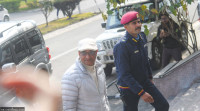National
In quest for the ‘third force’, Bhattarai and Yadav discuss party merger
Days after the promulgation of the constitution in September 2015, Baburam Bhattarai quit the Maoist party and severed his ties with Pushpa Kamal Dahal—Bhattarai’s comrade in arms for years, together with whom he had waged the “people’s war”.
Tika R Pradhan
Days after the promulgation of the constitution in September 2015, Baburam Bhattarai quit the Maoist party and severed his ties with Pushpa Kamal Dahal—Bhattarai’s comrade in arms for years, together with whom he had waged the “people’s war”.
The war against the state was aimed at writing a new constitution through a constituent assembly, overthrowing the monarchy, federating the state and setting the efforts to create an equal and just society in motion. The human cost of the war stood at 16,000.
But just 11 days after the promulgation of the constitution, Bhattarai decided to chart a new course. He went on to establish a new party—Naya Shakti Party—in a bid to what he called build “a new alternative political force”.
In the months leading up to the constitution promulgation, Upendra Yadav, along with other Madhesi leaders, was spearheading protests, saying that the constitution-drafting process was flawed and the stakeholders—mainly then CPN-UML, led by Oli; the erstwhile CPN (Maoist Centre), led by Dahal; and the Nepali Congress, led by Sushil Koirala—were ignoring the the concerns of the Madhesis, Tharus and Janajatis.
Months-long protests saw deaths of at least 50 people along the Tarai plains, but that did not stop the Constituent Assembly from promulgating the new charter in September 2015 amid protests from Yadav’s Sanghiya Samjabadi Forum-Nepal and other Madhes-based forces, including the then Samyukta Loktantrik Madhesi Morcha and other indigenous groups.
Following protests, the CA-turned-Parliament in January 2016 made a first amendment to the constitution. But the Madhesi, Janajati and Tharu forces were still not happy.
Fast forward to 2017.
Bhattarai’s Naya Shakti fared badly in the parliamentary elections held in November and December that year. He is the only member from his party in the federal Parliament.
Yadav’s party won 16 seats to become the fourth largest party in the federal Parliament.
Yadav’s Forum that was always averse to Oli’s CPN-UML, which after merging with Dahal’s Maoist party has become the Nepal Communist Party (NCP), is now part of the government. He is currently the deputy prime minister and health minister.
Bhattarai’s Naya Shakti, since its establishment, has been groping in the dark.
After a failed attempt in 2017, Bhattarai and Yadav are in talks once again to join hands.
Bhattarai and Yadav on Thursday held an informal meeting at the Babarmahal-based headquarters of the Naya Shakti. The meeting was also joined by the Rastriya Janata Party-Nepal leaders—Mahantha Thakur and Rajendra Mahato—and President of Janamukti Party Nepal Malbar Singh Thapa.
Bhattarai and Yadav, according to leaders, are in a bid to form “a strong third force” to promote inclusiveness, good governance and prosperity.
“This is an attempt to develop a third force in the country after the Nepal Communist Party and the Nepali Congress,” said Devendra Parajuli, a secretariat member of the Naya Shakti Party Nepal.
For Bhattarai and Yadav, the need to come together arises from several factors. While Bhattarai’s quest for building a new force—accordingly he chose the name Naya Shakti (which is a translation of ‘new force’)—has largely failed.
Bhattarai in September 2017 was present at a joint programme of the then UML and Maoist parties to form the biggest force in the country. But later he decided not to join hands with Oli and Dahal after there were disagreements over dividing constituencies as well as the name of the new party.
For Yadav, who rose in politics through his promises to serve the people of the Madhes and amend the constitution, concerns are growing, as his party has largely failed to deliver. Since his party joined the government, the constitution amendment issue seems to have been forgotten.
In March, the Oli government managed to force CK Raut, who had been demanding a separate Madhes state, to mainstream politics.
While Oli and Dahal are in a bid to centralise power, and Raut has formed his own party, the Sanghiya Samajbadi Forum-Nepal fears losing ground in the plains.
Ashok Rai, a senior leader of the Sanghiya Samajbadi Forum-Nepal, confirmed to the Post that talks are going on with Naya Shakti for a merger.
“We are seeking ways to merge with like-minded parties,” said Rai.
But it is unclear when and how the two parties will unite. It is also not clear whether the Naya Shakti Party will merge with a political force that is part of the incumbent government.
The Sanghiya Samajabadi Forum-Nepal also maintains that it will quit the government if its demand for constitutional amendments goes unaddressed.
Addressing the first meeting of the budget session of the federal parliament on April 29, Rajendra Shrestha, co-chairman of the Sanghiya Samajbadi Forum-Nepal, had hinted that his party could abandon the Oli government.
“Our party will quit the government if it fails to begin the process of amending the constitution as per the two-point agreement the ruling party leaders signed with us,” lawmaker Shrestha told the House.
“If the merger process moves ahead, the Sanghiya Samajbadi Forum-Nepal will have to pull out of the Oli government,” said Rajendra Mahato, a leader of the Rastriya Janata Party Nepal. “A party cannot be both in the government and the opposition.”
According to an understanding reached at the informal meeting, Bhattarai would coordinate further meetings of the parties to develop a political front or a working alliance for now, which the leaders believe would culminate in a strong political force.
“We have decided to form a working alliance of four parties before the Naya Shakti Party and the Sanghiya Samajbadi Forum-Nepal declare merger,” said Thapa of the Janamukti Party, after the four-party meeting.
The four parties have also agreed to continue discussions among them by forming panels of the party leaders.
“We are open to unification with like-minded parties and our party has already made an appeal for an working alliance with the forces fighting for the same cause,” said Mahantha Thakur, a leader of the Rastriya Janata Party-Nepal.
Asked about the reason behind the formation of such alliance at this point of time, Thakur said they wanted to develop a strong opposition front to counter the Oli government.
The Rastriya Janata Party-Nepal, which withdrew its support to the Oli government on March 6 after Kailali District Court handed down life sentence to its elected representative Resham Chaudhary, is part of the coalition government in Province 2.
“A strong alternative force is the need of the hour,” said Mahato, a leader of the Rastriya Janata Party-Nepal.
“It’s just a beginning. We will bring all the forces fighting for inclusiveness together. A unification coordination committee will be formed soon,” he added.




 7.12°C Kathmandu
7.12°C Kathmandu













%20(1).jpg&w=300&height=200)

